Three-Dimensional High-Energy Electron Radiography Method for Static Mesoscale Samples Diagnostics
Abstract
:1. Introduction
2. The TDHEER Method and General Layout
3. The Start-to-End Simulation Studies of TDHEER Method
3.1. The Imaging Lens Design
3.2. The HEER Simulation Studies with Rotating Sample
3.3. Three-Dimensional Reconstruction and Results Analysis
3.4. TDHEER Studies for Complicated Samples
4. Conclusions and Discussions
Author Contributions
Funding
Conflicts of Interest
References
- Gai, W.; Qiu, J.; Jing, C. Electron imaging system for untrafast diagnostics of HEDLP. In Proceedings of the SPIE 9211, Target Diagnostics Physics and Engineering for Inertial Confinement Fusion III, San Diego, CA, USA, 10 September 2014; p. 921104. [Google Scholar]
- Zhao, Y.; Zhang, Z.; Gai, W.; Du, Y.; Cao, S.; Qiu, J.; Zhao, Q.; Cheng, R.; Zhou, X.; Ren, J.; et al. High energy electron radiography scheme with high spatial and temporal resolution in three dimensions based on a e-LINAC. Laser Part. Beams 2016, 34, 338–342. [Google Scholar] [CrossRef]
- Merrill, F.; Harmon, F.; Hunt, A.; Mariam, F.; Morley, K.; Morris, C.; Saunders, A.; Schwartz, C. Electron radiography. Nucl. Instrum. Methods Phys. Res. B 2007, 26, 382–386. [Google Scholar] [CrossRef]
- Zhao, Q.; Cao, S.; Cheng, R.; Shen, X.; Zhao, Z.Z.Y.; Gai, W.; Du, Y. High Energy Electron Radiography Experiment Research Based on Picosencond Pulse Width Bunch. In Proceedings of the LINAC2014, Geneva, Switzerland, 31 August–5 September 2014; pp. 76–79. [Google Scholar]
- Zhao, Q.; Cao, S.C.; Liu, M.; Shen, X.K.; Wang, Y.R.; Zong, Y.; Zhang, X.M.; Jing, Y.; Cheng, R.; Zhao, Y.T.; et al. High energy electron radiography system design and simulation study of beam angle-position correlation and aperture effect on the images. Nucl. Instrum. Methods Phys. Res. A 2016, 832, 144–151. [Google Scholar] [CrossRef]
- Zhou, Z.; Du, Y.; Cao, S.; Zhang, Z.; Huang, W.; Chen, H.; Cheng, R.; Chi, Z.; Liu, M.; Su, X.; et al. Experiments on bright field and dark field high energy electron imaging with thick target material. Phys. Rev. Accel. Beams 2018, 21, 074701. [Google Scholar] [CrossRef]
- Zhao, Q.T.; Cao, S.C.; Cheng, R.; Du, Y.C.; Shen, X.K.; Wang, Y.R.; Xiao, J.H.; Zong, Y.; Zhu, Y.L.; Zhou, Y.W.; et al. Generation of uniform transverse beam distributions for high-energy electron radiography. Laser Part. Beams 2018, 36, 313–322. [Google Scholar] [CrossRef]
- Zhao, Q.T.; Cao, S.C.; Shen, X.K.; Wang, Y.R.; Zong, Y.; Xiao, J.H.; Zhu, Y.L.; Zhou, Y.W.; Liu, M.; Cheng, R.; et al. Design and simulation study of ultra-fast beam bunches split for three orthogonal planes high-energy electron dynamic radiography. Laser Part. Beams 2017, 35, 579–586. [Google Scholar] [CrossRef]
- Zhou, Z.; Fang, Y.; Chen, H.; Wu, Y.; Du, Y.; Yan, L.; Tang, C.; Huang, W. Demonstration of Single-Shot High-Quality Cascaded High-Energy-Electron Radiography using Compact Imaging Lenses Based on Permanent-Magnet Quadrupoles. Phys. Rev. Appl. 2019, 11, 034068. [Google Scholar] [CrossRef]
- Hemminger, J.; Crabtree, G.; Sarrao, J. From Quanta to the Continuum: Opportunities for Mesoscale Science. In A Report from the Basic Energy Sciences Advisory Committee; U.S. Department of Energy: Washington, DC, USA, 2012. [Google Scholar]
- Kak, A.C.; Slaney, M. Principles of Computerized Tomographic Imaging; IEEE Press: New York, NY, USA, 1999. [Google Scholar]
- Berz, M.; Makino, K. COSY INFINITY 9.1 Beam Physics Manual; MSU Report MSUHEP 060804-Rev; MSU: East Lansing, MI, USA, 2013. [Google Scholar]
- EGS (Electron Gamma Shower). Available online: http://rcwww.kek.jp/research/egs/ (accessed on 22 August 2019).
- Young, L.M. Parmela; LA-UR-96-1835; Los Alamos National Laboratory: Los Alamos, NM, USA, 23 May 2005.
- Penczek, P.A. Fundamentals of three-dimensional reconstruction from projections. Methods Enzymol. 2010, 482, 1–33. [Google Scholar] [CrossRef] [PubMed]
- Skilling, J.; Bryan, R.K. Maximum entropy image reconstruction: General algorithm. Mon. Not. R. Astron. Soc. 1984, 211, 111–124. [Google Scholar] [CrossRef]
- Frank, J. Electron Tomography-Methods for Three-Dimensional Visualization of Structures in the Cell, 2nd ed.; Springer: Berlin/Heidelberg, Germany, 2005. [Google Scholar]
- Miao, J.; Ercius, P.; Billinge, S.J. Atomic electron tomography: 3D structures without crystals. Science 2016, 353, aaf2157. [Google Scholar] [CrossRef] [PubMed]
- Zeng, G.L. Revisit of the Ramp Filter. IEEE Trans. Nucl. Sci. 2015, 62, 131–136. [Google Scholar] [CrossRef] [PubMed]
- Zhu, Y.; Yuan, P.; Cao, S.; Liu, M.; Zong, Y.; Zhao, Q.; Zhang, J.; Shen, X.; Zhang, Z. Design and simulation of a LINAC for high energy electron radiography Research. Nucl. Instrum. Methods Phys. Res. A 2018, 911, 74–78. [Google Scholar] [CrossRef]
- Volegov, P.L.; Danly, C.R.; Merrill, F.E.; Simpson, R.; Wilde, C.H. On three-dimensional reconstruction of a neutron/x-ray source from very few two dimensional Projections. J. Appl. Phys. 2015, 118, 205903. [Google Scholar] [CrossRef]
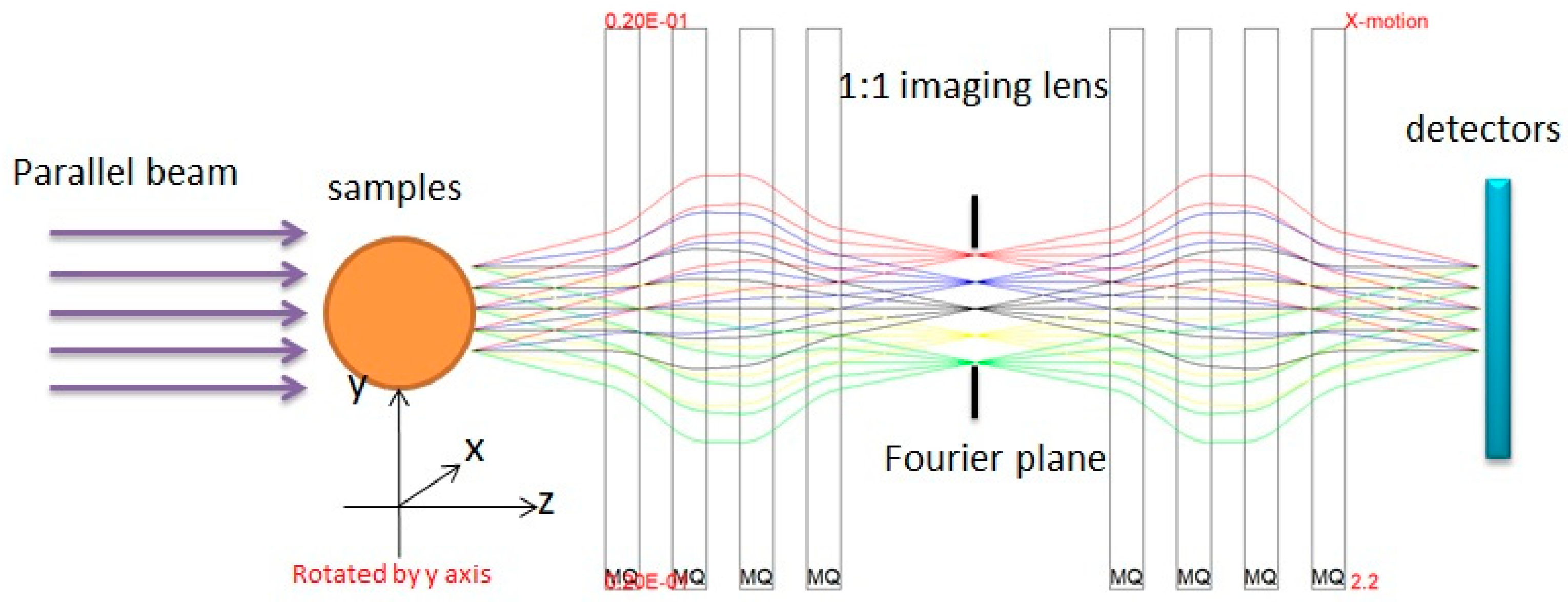
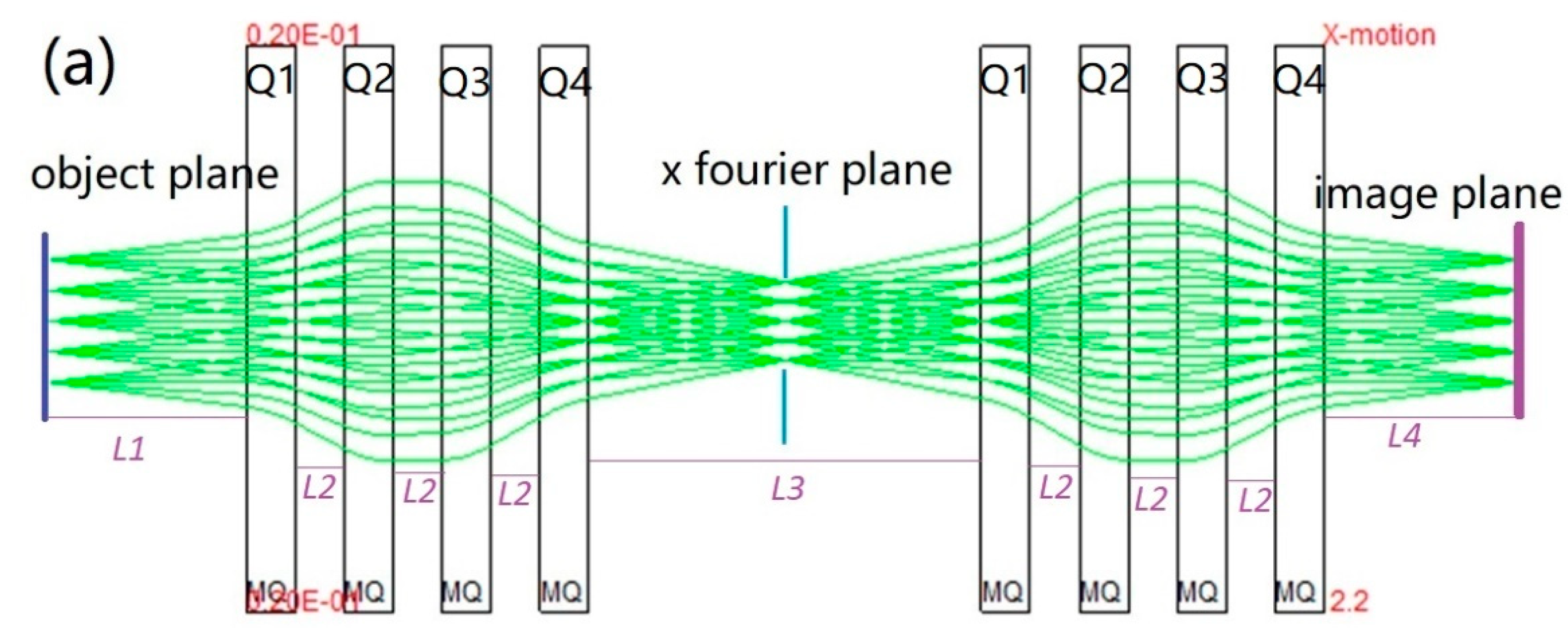
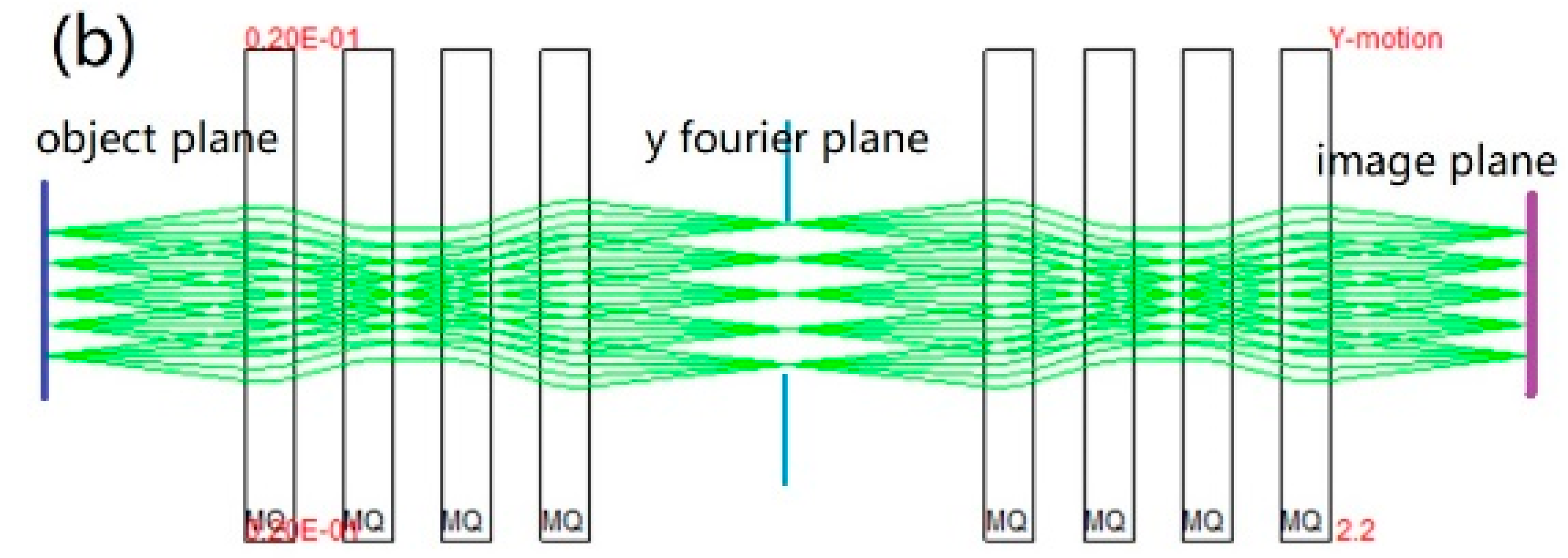
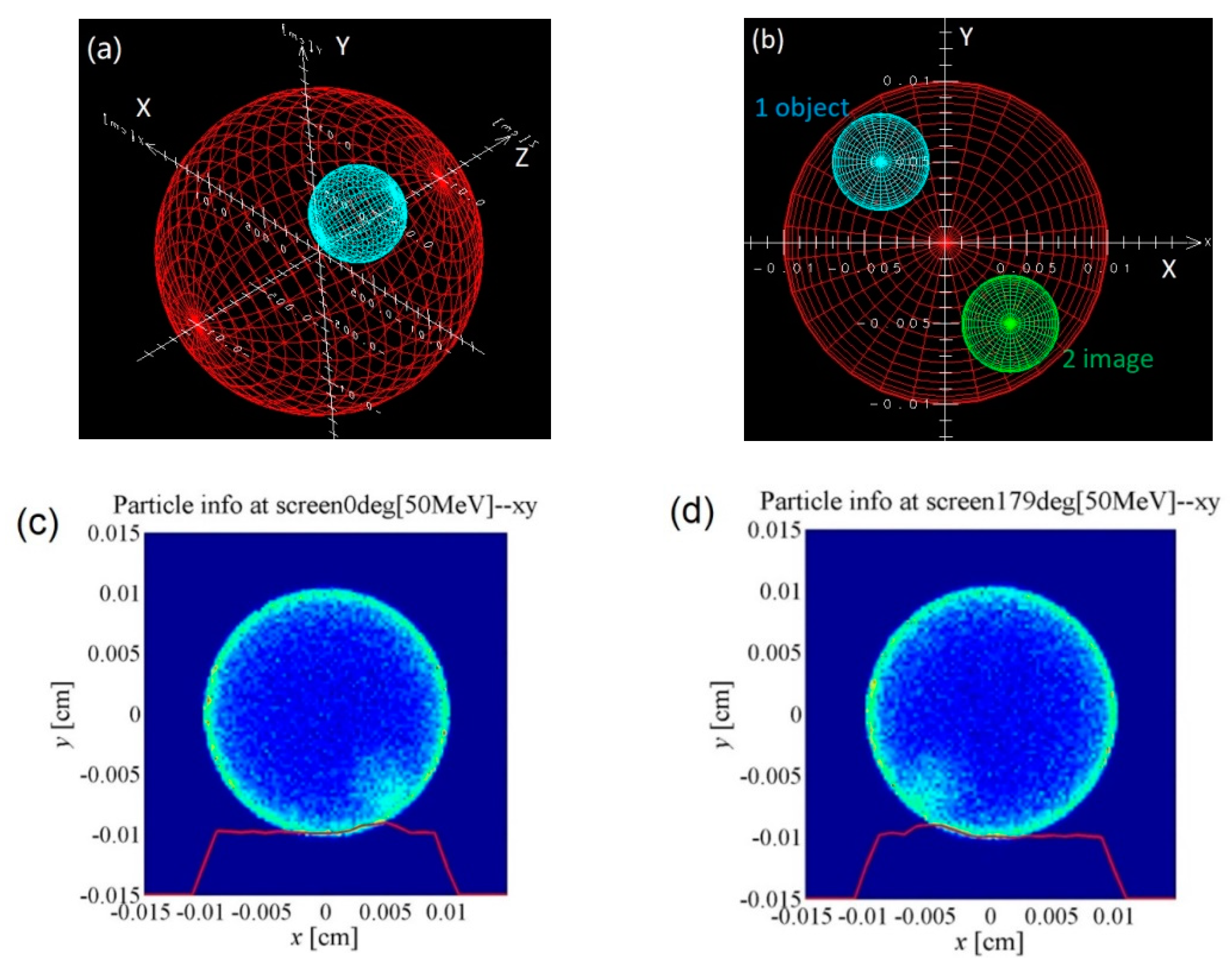


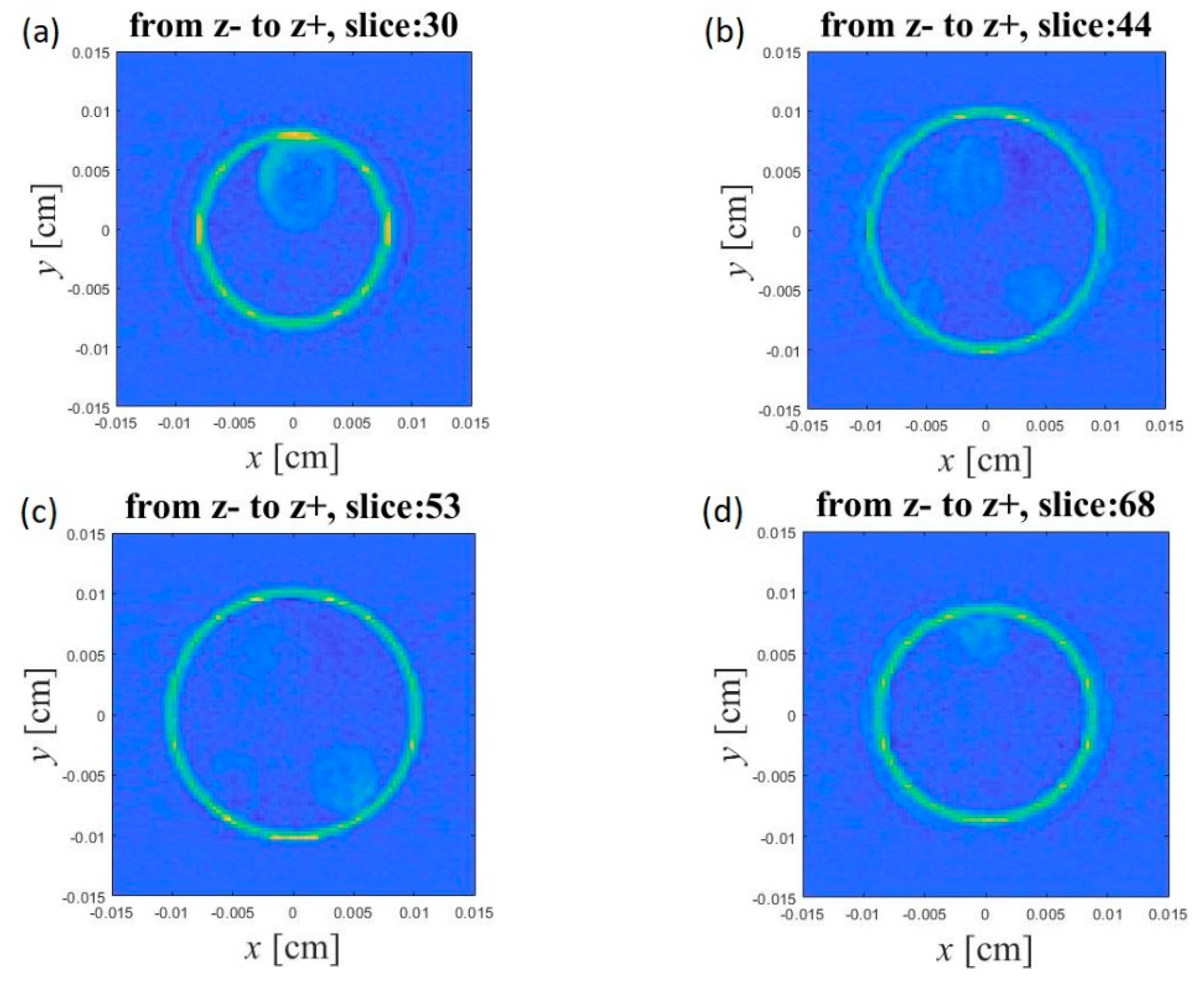
| Quads | Flux Density at Pole Tip B (T) | Transport Matrix Element | Optimized Transport Matrix Element Values | Drift | Drift Distance (m) |
|---|---|---|---|---|---|
| Q1 | 0.036593 | R11 = R33 | −1.0 | L1 | 0.4 |
| Q2 | −0.03382 | R12 = R34 [m/rad] | 0 | L2 | 0.1 |
| Q3 | −0.03382 | T116, T126 [m/rad] | 0, 3.05279 | L3 | 0.8 |
| Q4 | 0.036593 | T336, T346 [m/rad] | 0, 3.24576 | L4 | 0.4 |
| Sample/Material | X (cm) | Y (cm) | Z (cm) | R (cm) |
|---|---|---|---|---|
| Red and big/aluminum | 0 | 0 | 0 | 0.01 |
| Blue and small/hollow | −0.004 | 0.005 | 0 | 0.003 |
| Inner Ball/Material | X (cm) | Y (cm) | Z (cm) |
|---|---|---|---|
| Hollow (original settings) | −0.004 | 0.005 | 0 |
| Hollow (reconstruction results) | 0.0042 ± 0.0003 | −0.0054 ± 0.0003 | 0 ± 0.0003 |
| Sample Number/Material | X (cm) | Y (cm) | Z (cm) | R (cm) |
|---|---|---|---|---|
| 1/aluminum | 0 | 0 | 0 | 0.01 |
| 2/hollow | 0.005 | 0.006 | 0 | 0.002 |
| 3/hollow | 0 | −0.004 | −0.005 | 0.003 |
| 4/tungsten | −0.004 | 0.005 | 0 | 0.003 |
| 5/tungsten | 0 | −0.006 | 0.005 | 0.002 |
© 2019 by the authors. Licensee MDPI, Basel, Switzerland. This article is an open access article distributed under the terms and conditions of the Creative Commons Attribution (CC BY) license (http://creativecommons.org/licenses/by/4.0/).
Share and Cite
Zhao, Q.; Ma, Y.; Xiao, J.; Cao, S.; Shen, X.; Zhou, Y.; Ran, Z.; Zhang, Z. Three-Dimensional High-Energy Electron Radiography Method for Static Mesoscale Samples Diagnostics. Appl. Sci. 2019, 9, 3764. https://doi.org/10.3390/app9183764
Zhao Q, Ma Y, Xiao J, Cao S, Shen X, Zhou Y, Ran Z, Zhang Z. Three-Dimensional High-Energy Electron Radiography Method for Static Mesoscale Samples Diagnostics. Applied Sciences. 2019; 9(18):3764. https://doi.org/10.3390/app9183764
Chicago/Turabian StyleZhao, Quantang, Yuanyuan Ma, Jiahao Xiao, Shuchun Cao, Xiaokang Shen, Youwei Zhou, Zhaohui Ran, and Zimin Zhang. 2019. "Three-Dimensional High-Energy Electron Radiography Method for Static Mesoscale Samples Diagnostics" Applied Sciences 9, no. 18: 3764. https://doi.org/10.3390/app9183764
APA StyleZhao, Q., Ma, Y., Xiao, J., Cao, S., Shen, X., Zhou, Y., Ran, Z., & Zhang, Z. (2019). Three-Dimensional High-Energy Electron Radiography Method for Static Mesoscale Samples Diagnostics. Applied Sciences, 9(18), 3764. https://doi.org/10.3390/app9183764





